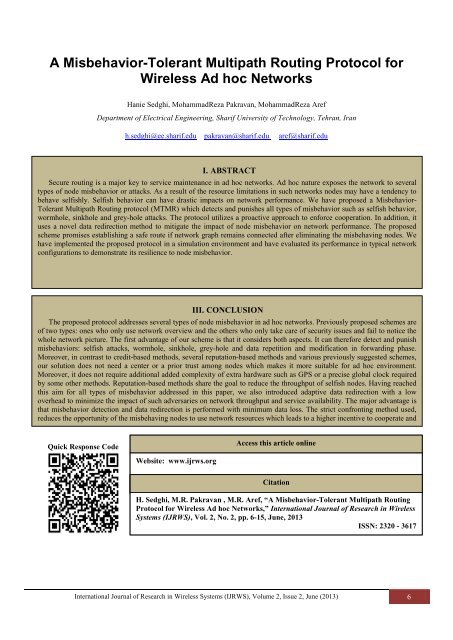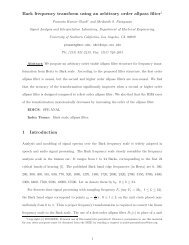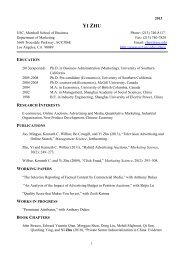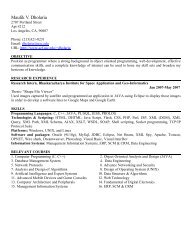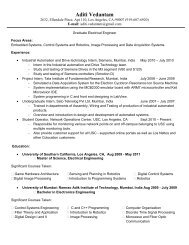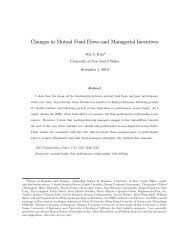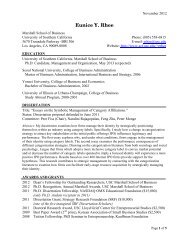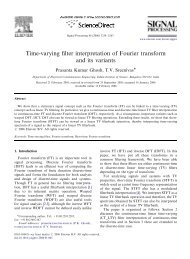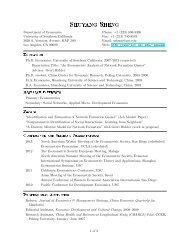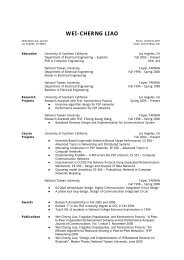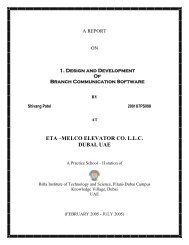A Misbehavior-Tolerant Multipath Routing Protocol for Wireless Ad ...
A Misbehavior-Tolerant Multipath Routing Protocol for Wireless Ad ...
A Misbehavior-Tolerant Multipath Routing Protocol for Wireless Ad ...
Create successful ePaper yourself
Turn your PDF publications into a flip-book with our unique Google optimized e-Paper software.
A <strong>Misbehavior</strong>-<strong>Tolerant</strong> <strong>Multipath</strong> <strong>Routing</strong> <strong>Protocol</strong> <strong>for</strong><br />
<strong>Wireless</strong> <strong>Ad</strong> hoc Networks<br />
Hanie Sedghi, MohammadReza Pakravan, MohammadReza Aref<br />
Department of Electrical Engineering, Sharif University of Technology, Tehran, Iran<br />
h.sedghi@ee.sharif.edu pakravan@sharif.edu aref@sharif.edu<br />
I. ABSTRACT<br />
Secure routing is a major key to service maintenance in ad hoc networks. <strong>Ad</strong> hoc nature exposes the network to several<br />
types of node misbehavior or attacks. As a result of the resource limitations in such networks nodes may have a tendency to<br />
behave selfishly. Selfish behavior can have drastic impacts on network per<strong>for</strong>mance. We have proposed a <strong>Misbehavior</strong>-<br />
<strong>Tolerant</strong> <strong>Multipath</strong> <strong>Routing</strong> protocol (MTMR) which detects and punishes all types of misbehavior such as selfish behavior,<br />
wormhole, sinkhole and grey-hole attacks. The protocol utilizes a proactive approach to en<strong>for</strong>ce cooperation. In addition, it<br />
uses a novel data redirection method to mitigate the impact of node misbehavior on network per<strong>for</strong>mance. The proposed<br />
scheme promises establishing a safe route if network graph remains connected after eliminating the misbehaving nodes. We<br />
have implemented the proposed protocol in a simulation environment and have evaluated its per<strong>for</strong>mance in typical network<br />
configurations to demonstrate its resilience to node misbehavior.<br />
III. CONCLUSION<br />
The proposed protocol addresses several types of node misbehavior in ad hoc networks. Previously proposed schemes are<br />
of two types: ones who only use network overview and the others who only take care of security issues and fail to notice the<br />
whole network picture. The first advantage of our scheme is that it considers both aspects. It can there<strong>for</strong>e detect and punish<br />
misbehaviors: selfish attacks, wormhole, sinkhole, grey-hole and data repetition and modification in <strong>for</strong>warding phase.<br />
Moreover, in contrast to credit-based methods, several reputation-based methods and various previously suggested schemes,<br />
our solution does not need a center or a prior trust among nodes which makes it more suitable <strong>for</strong> ad hoc environment.<br />
Moreover, it does not require additional added complexity of extra hardware such as GPS or a precise global clock required<br />
by some other methods. Reputation-based methods share the goal to reduce the throughput of selfish nodes. Having reached<br />
this aim <strong>for</strong> all types of misbehavior addressed in this paper, we also introduced adaptive data redirection with a low<br />
overhead to minimize the impact of such adversaries on network throughput and service availability. The major advantage is<br />
that misbehavior detection and data redirection is per<strong>for</strong>med with minimum data loss. The strict confronting method used,<br />
reduces the opportunity of the misbehaving nodes to use network resources which leads to a higher incentive to cooperate and<br />
Quick Response Code<br />
Access this article online<br />
Website: www.ijrws.org<br />
ISSN<br />
Citation<br />
H. Sedghi, M.R. Pakravan , M.R. Aref, “A <strong>Misbehavior</strong>-<strong>Tolerant</strong> <strong>Multipath</strong> <strong>Routing</strong><br />
<strong>Protocol</strong> <strong>for</strong> <strong>Wireless</strong> <strong>Ad</strong> hoc Networks,” International Journal of Research in <strong>Wireless</strong><br />
Systems (IJRWS), Vol. 2, No. 2, pp. 6-15, June, 2013<br />
ISSN: 2320 - 3617<br />
International Journal of Research in <strong>Wireless</strong> Systems (IJRWS), Volume 2, Issue 2, June (2013) 6
A <strong>Misbehavior</strong>-<strong>Tolerant</strong> <strong>Multipath</strong> <strong>Routing</strong> <strong>Protocol</strong> <strong>for</strong> <strong>Wireless</strong> <strong>Ad</strong> hoc Networks<br />
I. INTRODUCTION<br />
<strong>Wireless</strong> ad-hoc networks are becoming increasingly<br />
popular with a diverse range of applications. In many ad-hoc<br />
networks, nodes act as a source, destination or router of<br />
in<strong>for</strong>mation. There<strong>for</strong>e, a packet may pass multiple hops, being<br />
<strong>for</strong>warded by interim nodes acting as routers, to reach its<br />
destination. If some nodes within an ad-hoc network do not<br />
route properly, due to reasons such as selfishness, the network<br />
cannot function as expected. There<strong>for</strong>e, misbehavior of nodes<br />
can severely impact proper operation of the network.<br />
<strong>Ad</strong> hoc nature of the network implies that there are no<br />
infrastructures or central control system in the network. Also,<br />
nodes have limited radio range, computational power and<br />
battery power. This makes such networks vulnerable to several<br />
attacks such as wormhole, sinkhole, grey hole, impersonation,<br />
flooding, misleading routes and selfish attacks [1].<br />
Wormhole attack is believed to be one of the most severe<br />
active attacks. Attacks per<strong>for</strong>med by malicious nodes who<br />
deliberately try to harm network per<strong>for</strong>mance are called<br />
active. Wormhole is the creation of a tunnel between two<br />
colluding nodes linked through a private network connection.<br />
This exploit allows them to short-circuit the normal flow of<br />
routing messages by falsifying the widely-used hop count<br />
metric [2].<br />
One prominent idea <strong>for</strong> detecting a wormhole was based<br />
on packet leashes [3]. This scheme needs authenticating either<br />
an extremely precise timestamp or location in<strong>for</strong>mation<br />
combined with a loose timestamp. There<strong>for</strong>e it is not<br />
applicable in ad hoc networks. Another approach uses hash<br />
chain and public key infrastructure to detect a wormhole [4].<br />
As a result of ad hoc nature, a CA (Certificate Authority) is<br />
not an easily applicable assumption. There<strong>for</strong>e public key<br />
infrastructure implementation is a challenge. Moreover, the<br />
scheme falsely accuses all benign nodes that happen to be on<br />
the same route as the wormhole.<br />
In many types of ad hoc networks, nodes have limited<br />
energy and computational power. There<strong>for</strong>e, nodes will benefit<br />
from executing algorithms that keep their resources to<br />
themselves and that may result a selfish behavior in the<br />
network. Selfish nodes may not participate in routing data<br />
packets that does not belong to them, saving their resources. A<br />
game-theoretic approach to encourage energy sharing <strong>for</strong><br />
packet <strong>for</strong>warding is proposed in [5]. Selfish behavior<br />
introduces a type of denial of service (DoS) attack. In addition<br />
to denial of service, selfish behavior results in route loss, data<br />
loss, throughput reduction and in the worst case, network<br />
decomposition. It should be noted that, in comparison with<br />
other known attacks, this attack is not per<strong>for</strong>med by nodes that<br />
have the tendency to hurt network, namely malicious nodes. It<br />
is done by normal nodes who behave rationally to save their<br />
resources. Considering the mentioned threats, it is of high<br />
importance to mitigate these types of misbehavior.<br />
Most ad hoc networks are composed of individual nodes all<br />
having the same priority. There<strong>for</strong>e, preventing selfishness can<br />
be reached by en<strong>for</strong>cing cooperation [6]. These methods can be<br />
divided to credit-based methods and reputation-based methods.<br />
Credit-based methods use economic incentives to encourage<br />
packet <strong>for</strong>warding. Cooperation is a service that can be<br />
evaluated and charged. They use a virtual currency which is<br />
implemented by either a tamper-proof hardware -virtual money<br />
- or a virtual bank. When a node wants to send a packet, it<br />
needs to have the money required by intermediate nodes [7],<br />
[8], [9]. Reputation-based methods are based on building<br />
reputation amongst nodes. Packet <strong>for</strong>warding increases node<br />
reputation. Only nodes having good reputation can send their<br />
data in the network and the route having the highest reputation<br />
is chosen. There<strong>for</strong>e selfish nodes are punished and isolated<br />
[10] [11] [12] [13] [14]. These methods use two types of<br />
in<strong>for</strong>mation: reputation in<strong>for</strong>mation received from other nodes<br />
and first hand in<strong>for</strong>mation which is the knowledge acquired by<br />
monitoring neighbors' behavior [6], [12]. Some reputationbased<br />
schemes use the idea of watchdog and pathrater [13].<br />
Another approach introduced recently, is a proactive<br />
cooperation mechanism to detect and punish selfish power off<br />
[15]. The method cannot detect more sophisticated selfish<br />
attacks like selfishness type II that will be introduced shortly.<br />
We propose a robust multipath routing protocol which<br />
detects all types of wormhole and selfishness known so far<br />
with low data loss. Utilizing a proactive approach, we apply<br />
the idea of reputation which is updated based on first hand<br />
in<strong>for</strong>mation and a simple but thorough method <strong>for</strong> earning and<br />
losing it. Proposed routing protocol uses an adaptive rerouting<br />
method to prevent complex misbehavior impacts, and also<br />
guarantees establishing a safe route if network graph remains<br />
connected after eliminating misbehaving nodes. We have<br />
implemented the protocol in a simulation environment and<br />
have evaluated its behavior in realistic network scenarios.<br />
The proposed method has the following salient features:<br />
1. It is simple and does not require a trusted third party, prior<br />
trust among nodes, GPS, precise clock and similar<br />
requirements which add to the system complexity.<br />
2. It can detect and bypass wormholes, sinkholes and greyholes<br />
successfully with a low overhead.<br />
3. It can accurately detect and re-act properly to both types of<br />
known selfish node behaviors. Most papers have not been<br />
completely successful in addressing both types.<br />
4. It uses first hand in<strong>for</strong>mation which are obtained by a node<br />
itself and that prevents issues that could arise from rumor<br />
spreading.<br />
5. Wormhole or selfish nodes neighbors are not wrongly<br />
accused.<br />
6. It does Dynamic Rerouting with minimum data loss to<br />
defend network per<strong>for</strong>mance against data packet drop<br />
attacks.<br />
7. It does multipath routing to decrease rerouting overhead<br />
and achieves that with far less overhead compared to ideas<br />
applied be<strong>for</strong>e.<br />
8. It works well under congestion or link failures, temporary<br />
or long-lasting.<br />
9. It can be easily implemented on a 802.11 MAC.<br />
International Journal of Research in <strong>Wireless</strong> Systems (IJRWS), Volume 2, Issue 2, June (2013) 7
A <strong>Misbehavior</strong>-<strong>Tolerant</strong> <strong>Multipath</strong> <strong>Routing</strong> <strong>Protocol</strong> <strong>for</strong> <strong>Wireless</strong> <strong>Ad</strong> hoc Networks<br />
As a side improvement, we design a slightly more<br />
intelligent TCP, which <strong>for</strong>tifies our system greatly while<br />
defending against wormhole attack and makes our idea to<br />
outper<strong>for</strong>m all existing protocols.<br />
The remainder of this paper is organized as follows: Part<br />
two gives an overview of considered attacks and their impacts<br />
on network. <strong>Misbehavior</strong>-<strong>Tolerant</strong> <strong>Multipath</strong> <strong>Routing</strong> (MTMR)<br />
protocol is introduced in part three. In part four we prove some<br />
of MTMR properties. Part five defines simulation software,<br />
scenarios and results. Finally we conclude the paper in part six.<br />
II. CONSIDERED ATTACKS<br />
A. Wormhole<br />
Wormhole is the creation of a tunnel between two colluding<br />
nodes linked through a private network connection. The<br />
colluding nodes pretend to be neighbors while they are far<br />
from each other. There<strong>for</strong>e, if a routing protocol exploits hopcount<br />
metric, wormhole will always be interesting and<br />
selected to be on the routes. The attraction of network traffic<br />
to wormhole is regarded as if wormhole is short circuiting<br />
network traffic. Hop-count is a common metric used by most<br />
routing protocols. A wormhole pair can disrupt on average<br />
32% of all communications across the network [4]. Most<br />
proposed routing protocols have no means to detect<br />
wormholes or rely on not applicable or unfair ideas. The worst<br />
case attack happens when colluding nodes <strong>for</strong>ward route<br />
discovery messages but refuse to <strong>for</strong>ward data packets. This<br />
subtle misbehavior drastically degrades network per<strong>for</strong>mance.<br />
B. Selfishness<br />
Selfish behavior addressed so far, can be classified into two<br />
categories that are called selfishness type I and II. In the type I<br />
selfish behavior, the selfish node does not participate in route<br />
discovery process to avoid being on the route. This behavior<br />
has also been named selfish power off. In the type II selfish<br />
behavior, the selfish node participates in route discovery phase,<br />
<strong>for</strong>warding the control packets it receives but refuses to<br />
<strong>for</strong>ward data packets. In addition, a node may change its<br />
behavior based on its remaining power, to act as a benign node<br />
first and change to being selfish based on its remaining power.<br />
Form our algorithm perspective; this will not make the process<br />
more complicated. A detailed explanation follows shortly.<br />
Selfish behavior degrades fairness in the network. Benign<br />
nodes consume their power in processing and <strong>for</strong>warding<br />
packets of other nodes. In contrast, selfish nodes ignore other<br />
packets to keep their power to themselves. Moreover,<br />
selfishness makes benign nodes consume more energy.<br />
Considering selfishness type I, benign nodes will participate in<br />
more routes. If data retransmission is an issue in upper layers,<br />
Selfishness type II makes benign nodes <strong>for</strong>ward more data<br />
packets. This includes the source node and intermediate nodes<br />
on a route that contains a selfish node type II.<br />
C. Sinkhole and Grey-hole<br />
In the sinkhole attack, the attacker spreads wrong routing<br />
in<strong>for</strong>mation to attract network traffic to itself and discards the<br />
received traffic. A more complex <strong>for</strong>m is the grey-hole attack,<br />
where the colluder <strong>for</strong>wards routing messages but discards<br />
data packets to keep its false route.<br />
Wormhole and Selfish attacks can have devastating effects<br />
on the per<strong>for</strong>mance of ad hoc networks which can be<br />
classified as a Denial of Service Attack. They can lead to<br />
network decomposition. Selfish power off may lead to failure<br />
in discovering a route. Wormhole and Type II selfishness<br />
attacks decrease packet delivery ratio drastically. Sinkhole and<br />
grey-hole can be considered as moderate wormhole attacks.<br />
III. MTMR PROTOCOL<br />
We propose a misbehavior-tolerant multipath routing<br />
protocol. Two major approaches are introduced in MTMR.<br />
First of all a proactive cooperation en<strong>for</strong>cement method is used<br />
to detect and punish misbehaviors and reward cooperation.<br />
Secondly, an adaptive data redirection method is used to<br />
mitigate offender's impact on network per<strong>for</strong>mance.<br />
A. Cooperation en<strong>for</strong>cement<br />
Cooperation en<strong>for</strong>cement is based on local measurements.<br />
In addition to a noticeable reduction in transmission and<br />
processing overhead, this approach makes network resilient to<br />
several attacks such as rumor spreading. Every node monitors<br />
its one-hop neighbors' relevant transmissions and based on<br />
their cooperation traces (CT), decides whether to cooperate<br />
with them or not. This routine is per<strong>for</strong>med be<strong>for</strong>e routing<br />
decisions.<br />
The scheme is based on 5 basic operations.<br />
A table <strong>for</strong> keeping the traces: Each node maintains a table<br />
<strong>for</strong> its neighbors. The table contains node identity and the<br />
corresponding CT of its neighbors as shown in table1. Traces<br />
decrease in time so that a node who behaves well temporarily<br />
cannot take advantage of the given reputation <strong>for</strong> the rest of its<br />
presence in the network.<br />
2) A cooperation decision procedure: Received packet is<br />
processed and <strong>for</strong>warded if and only if sender cooperation trace<br />
is not zero.<br />
3) A procedure to give CTs. We apply different strategies<br />
<strong>for</strong> adding or removing CTs based on packet type.<br />
Control Packets: If a node receives a control packet from a<br />
neighbor who is not the packet source, it shows the<br />
corresponding neighbor is cooperating, so the receiver<br />
increases the neighbor's CT.<br />
Data packets: Whenever a node <strong>for</strong>wards a data packet to a<br />
neighbor, it keeps track of the behavior of its neighbor. If the<br />
next hop <strong>for</strong>wards the packet, it is granted CT and if it refuses<br />
to <strong>for</strong>ward the packet, its CT is reset. It should be noted that<br />
this observation is per<strong>for</strong>med by adding the sent packets to a<br />
buffer. Each buffer entry has a timer assigned to it. Packets<br />
<strong>for</strong>warded by neighbors (which in wireless medium can be<br />
International Journal of Research in <strong>Wireless</strong> Systems (IJRWS), Volume 2, Issue 2, June (2013) 8
A <strong>Misbehavior</strong>-<strong>Tolerant</strong> <strong>Multipath</strong> <strong>Routing</strong> <strong>Protocol</strong> <strong>for</strong> <strong>Wireless</strong> <strong>Ad</strong> hoc Networks<br />
received by the source as well as the next hop) are compared to<br />
buffer entries. If the <strong>for</strong>warded packet is in the buffer, the entry<br />
is removed and the neighbor is granted a CT. On the other<br />
hand, if the timer is reset, it shows neighbor misbehavior and<br />
neighbor CT is reset. This approach <strong>for</strong>tifies the protocol<br />
against attacks that modify or repeat data packets in <strong>for</strong>warding<br />
phase. The key idea is that if the misbehaving node changes or<br />
repeats the data packet, the new packet is not in the sender's<br />
buffer and the offender does not gain CT <strong>for</strong> that. In addition, if<br />
the offender does not <strong>for</strong>ward the original packet at all, after<br />
corresponding buffer entry’s timer is expired, its CT is reset.<br />
CT is the key <strong>for</strong> acceptance in network. According to the<br />
cooperation decision procedure, if a node's CT is zero, the<br />
neighbor will not cooperate with it and such a node is<br />
punished. Considering nodes' limited resources, punishment<br />
entices such misbehaving nodes to act well.<br />
Granting CT is achieved by increasing node’s CT by size of<br />
packet cooperation value if the node is already in CT table, or<br />
by adding the neighbor to the CT table and giving it a CT equal<br />
to packet cooperation value in the other case. Different packet<br />
types have different cooperation values.<br />
4) A procedure to reset CTs: as mentioned above, CTs are<br />
decreased in time and reset if an offence is noticed. There<strong>for</strong>e<br />
occasions may occur when parts of the network CTs have<br />
decreased in time and become zero. In such cases, a deadlock<br />
happens.<br />
5) A deadlock solution: Occasions may occur when a node<br />
or a part of network cooperation traces are expired. In this<br />
situation a deadlock occurs. To avoid this, when a source node<br />
detects a deadlock (by having its RREQ expired without<br />
receiving a RREP), it sets a Cooperation Request (CR) flag in<br />
its RREQ packet and broadcasts the RREQ. A neighbor<br />
detecting the flag from a source gives it a temporary CT and<br />
increases the counter <strong>for</strong> its credit requests, CR counter. A<br />
granted CT’s value is less than <strong>for</strong>warding packet CTs.<br />
Moreover <strong>for</strong> each neighbor there is a limit on the number of<br />
CRs a node reacts to.CR flag is placed at RREQ packet's first<br />
hop field. The reason is that, this field is used in AOMDV [16]<br />
protocol but is not used in MTMR protocol.<br />
Table I. Cooperation Trace table<br />
Neighbor ID CT CR Counter<br />
N1 170 0<br />
N5 300 2<br />
… … …<br />
It should be noted that MTMR is fair and every node has<br />
the chance to join network by <strong>for</strong>warding packets <strong>for</strong> others.<br />
Since cooperation en<strong>for</strong>cement procedure is per<strong>for</strong>med be<strong>for</strong>e<br />
routing, edge nodes (i.e. nodes that are located at networks<br />
borders or are rarely chosen to be on a route) can gain CT by<br />
<strong>for</strong>warding RREQs be<strong>for</strong>e duplicates are ignored by routing<br />
procedure. There<strong>for</strong>e, border nodes and malfunction nodes are<br />
treated fairly. If some nodes are subject to some errors in MAC<br />
layer, this fairness helps them too.<br />
B. <strong>Multipath</strong> <strong>Routing</strong> and Data Redirection<br />
In order to minimize the impact of node misbehavior on<br />
network per<strong>for</strong>mance, it is not enough to punish offenders. It is<br />
needed to defend benign nodes throughput by finding safe<br />
routes. In order to reach this goal, we include a connection<br />
discovery phase in the protocol. A connection is a safe path<br />
without any misbehaving nodes. Connection discovery phase<br />
has two parts: route discovery and data redirection. Our<br />
multipath routing protocol is based on AOMDV (<strong>Ad</strong> hoc Ondemand<br />
<strong>Multipath</strong> Distance Vector) [16] but there are major<br />
differences. Like all other on-demand routings, when a source<br />
node wants to establish a connection, it broadcasts a Route<br />
Request packet (RREQ). Every node receiving a fresh copy of<br />
RREQ, updates its routing table with a new path to the source,<br />
and then searches its routing table to find a path to the<br />
destination. If a path is not found, it rebroadcasts the RREQ<br />
packet. Whenever a route to the destination is found or RREQ<br />
packet arrives at the destination, a Route Reply packet (RREP)<br />
is generated and sent to the source node. Unlike the AOMDV<br />
protocol who only finds at maximum three routes to the<br />
destination and sends back RREP on those discovered routes,<br />
we broadcast RREP packet to some hops. This is done so that<br />
nodes surrounding the discovered route get the in<strong>for</strong>mation<br />
about destination whereabouts. This modification is of great<br />
importance to implement the data redirection method.<br />
Source responds to the first received RREP packet. The<br />
ones coming afterwards are only used <strong>for</strong> updating routing<br />
tables. After receiving the route reply packet, source checks the<br />
first entry in the routing table <strong>for</strong> the desired destination. It also<br />
checks the corresponding next hop CR, if the CR is not zero;<br />
source <strong>for</strong>wards the packet to the specified next hop.<br />
Otherwise, the second best next hop is analyzed and so on.<br />
This approach is followed by the intermediate nodes as well.<br />
A fresh copy is a copy of a RREQ/RREP that has not been<br />
received from the same neighbor be<strong>for</strong>e. Utilizing this<br />
definition along with sequence number and hop count assures<br />
loop freedom.<br />
If the discovered route contains a disobedient node, data<br />
packets will be retransmitted and redirected. In order to avoid<br />
loop in data redirection phase, data packets contain a sequence<br />
number. Sequence number also in<strong>for</strong>ms the intermediate node<br />
that the copy is a fresh copy, here, a retransmitted data packet.<br />
Considering mentioned procedures, data redirection is a<br />
straight<strong>for</strong>ward decision. Any node receiving a fresh data<br />
checks its routing table and finds the first benign neighbor, i.e.<br />
the neighbor that owns a CR, and <strong>for</strong>wards the packet to it. If<br />
such a neighbor is not found, the node sends back the last data<br />
packet to the previous hop. In addition to optimizing data<br />
redirection, this operation prevents previous hop from falsely<br />
accusing the specified node. And hence, prohibits selfish<br />
spread. Selfish spread is the act of accusing benign nodes when<br />
they have no access to secure paths and thus do not <strong>for</strong>ward<br />
packets. Several misbehavior detection mechanisms such as [4]<br />
International Journal of Research in <strong>Wireless</strong> Systems (IJRWS), Volume 2, Issue 2, June (2013) 9
A <strong>Misbehavior</strong>-<strong>Tolerant</strong> <strong>Multipath</strong> <strong>Routing</strong> <strong>Protocol</strong> <strong>for</strong> <strong>Wireless</strong> <strong>Ad</strong> hoc Networks<br />
suffer from this imperfection. Moreover, this algorithm assures<br />
stopping the data transmission in case of congestion or when<br />
the attack is so severe that the network is decomposed. As can<br />
be seen, this abrupt redirection <strong>for</strong>tifies the system against the<br />
third type of selfishness.<br />
This strategy promises minimum data loss. The reason is<br />
that, even if a misbehaving node exists on the path and it has a<br />
fake cooperation trace as a result of a CR, as soon as it drops<br />
the first data packet, previous hop is in<strong>for</strong>med. Previous hop<br />
then resets the CT of misbehaving node and will not send the<br />
next data packet through the discovered misbehaving node.<br />
IV. MTMR PROPERTIES<br />
We introduce 6 properties of MTMR and provide heir<br />
proofs.<br />
Property I: If MTMR discovers a route between a source<br />
and its destination, the path is secure, i.e. it does not include<br />
misbehaving nodes.<br />
Proof I: Obviously, misbehaving nodes do not cooperate in<br />
<strong>for</strong>warding control or data packets. There<strong>for</strong>e, considering<br />
route discovery and connection discovery phase, selfish nodes<br />
type I will not be on the discovered route. Moreover, if a node<br />
is selfish type II, wormhole or sinkhole, it will be bypassed in<br />
rerouting of connection discovery phase. Consequently, only<br />
the nodes that <strong>for</strong>ward data and ACK packets as well as<br />
RREQ and RREP packets can participate in a MTMR<br />
connection. Applying indirect proof, suppose that a<br />
misbehaving node resides on a MTMR route, there<strong>for</strong>e, it will<br />
at least ignore <strong>for</strong>warding data packets or drops data packets.<br />
Noting the operation of MTMR as explained be<strong>for</strong>e, such a<br />
node can not be included in an MTMR path. This<br />
contradiction completes the proof.<br />
Property II: If MTMR discovers a route between source and<br />
destination, then at least one path exists from the source to the<br />
destination in the induced graph which is made by removing<br />
misbehaving nodes.<br />
Proof II: It can be easily deduced from property I that a<br />
MTMR-discovered path does not include misbehaving nodes.<br />
There<strong>for</strong>e, the path that MTMR has discovered remains in the<br />
induced graph which is made by removing misbehaving nodes<br />
and it will not be cut. Hence, the statement is true.<br />
Property III: For every intermediate ad hoc node, MTMR<br />
protocol checks all of its neighbors once.<br />
Proof III: MTMR protocol strategy is as follows: If the<br />
intermediate node is connected to the destination, the source<br />
sends data to this node until the node tells the previous hop<br />
that it has processed all paths and cannot find a path to reach<br />
the destination. There<strong>for</strong>e, the intermediate node rejects the<br />
data packet by returning it to the previous hop.<br />
After receiving a data packet towards the destination (D),<br />
intermediate node chooses the next hop specified by its table<br />
index <strong>for</strong> D. It always checks next hop CR be<strong>for</strong>e <strong>for</strong>warding<br />
the packet. If the next hop specified by the table does not have<br />
a CR, the next table entry is checked and so on. If the<br />
intermediate node checks all the entries and does not find a<br />
benign next hop, it gives back the data packet. We apply<br />
inductive reasoning to show that. As induction assumption,<br />
suppose that if intermediate node is destination's k-th level<br />
neighbor (i.e. it is k-hop away from destination), all of its<br />
neighbors will be checked. Now consider the intermediate<br />
node of level k+1. Because of our limited directive flooding,<br />
all of this node's table entries <strong>for</strong> D are of level k. (Limited<br />
directive flooding means that in flooding phase, every node<br />
<strong>for</strong>wards the received RREQ/RREP to all its neighbors except<br />
the node that had flooded that packet in the previous step).<br />
According to induction assumption, all the neighbors <strong>for</strong> a<br />
node of level k are checked and finally that node sends a<br />
return message to the k+1-th level node .This way, the k+1-th<br />
level neighbor checks all its neighbors.<br />
Property IV: MTMR does not process any route twice.<br />
Proof IV: Since routes are processed solely by nodes that<br />
participate in them, if a route is processed twice it means there<br />
exists an intermediate node that has checked a specific<br />
neighbor twice. According to property III such a case is not<br />
possible. Since source node can be considered the last<br />
intermediate node (from destination side), it can be easily<br />
concluded from induction that there is no such probability <strong>for</strong><br />
the source node too.<br />
Property V: Data packets follow the same path as RREQ<br />
packets.<br />
Proof V: This is due to the fact that intermediate nodes<br />
direct their routing tables as RREQ packets are flooded in the<br />
network.<br />
Property VI: MTMR processes loop-free routes.<br />
Proof VI: Considering the utilized strategy in route<br />
discovery phase, RREQ packets do not follow loops. The<br />
reason is that MTMR uses loop avoidance mechanisms such<br />
as SQN (Sequence Number) and limited directive flooding.<br />
There<strong>for</strong>e, as a result of property V, data packets do not follow<br />
loops.<br />
V. SIMULATION<br />
Credit-based methods may not be appropriate <strong>for</strong> ad hoc<br />
nature. That is due to the fact that ad hoc networks lack<br />
infrastructure and certificate distribution centers. There<strong>for</strong>e,<br />
ideas based on virtual currency or virtual bank will be difficult<br />
to implement in such networks. Moreover, there is no<br />
guarantee that intermediate nodes receive source money. It has<br />
been verified that if node density is not low, AODV [17]<br />
based multipath routing protocols (such as AOMDV) achieve<br />
a better per<strong>for</strong>mance and less routing overhead than DSR [18]<br />
based multipath routing protocols [19]. Data redirection has<br />
only been applied in [12] and it is based on DSR. There<strong>for</strong>e,<br />
since MTMR is based on AODV, it uses a very low routing<br />
overhead compared to previously introduced schemes.<br />
Moreover, it uses a multipath routing method which is an<br />
efficient method in networks facing link breakage or mobility<br />
[16]. It also imposes less monitoring and processing load to<br />
the neighbor nodes compared to some watchdog based<br />
protocols [12], in which every node has to monitor all<br />
neighbors' traffic even when not addressed to it. Proactive<br />
International Journal of Research in <strong>Wireless</strong> Systems (IJRWS), Volume 2, Issue 2, June (2013) 10
A <strong>Misbehavior</strong>-<strong>Tolerant</strong> <strong>Multipath</strong> <strong>Routing</strong> <strong>Protocol</strong> <strong>for</strong> <strong>Wireless</strong> <strong>Ad</strong> hoc Networks<br />
cooperation mechanism used in [15] can only detect selfish<br />
power off. Proposed scheme does not use a threshold <strong>for</strong><br />
detection. Threshold-based decisions [14] give misbehaving<br />
nodes the opportunity to use network resources.<br />
There<strong>for</strong>e, to inspect proposed scheme behavior, MTMR is<br />
compared to defenseless scenario, AOMDV routing protocol.<br />
This is to inspect the pros and cons of intended misbehavioraware<br />
routing.<br />
We have designed a new network simulator named MARS:<br />
MAnet <strong>Routing</strong> Simulator to investigate the per<strong>for</strong>mance of<br />
the proposed protocol in realistic network scenarios. MARS is<br />
written in Visual C++ programming language and is designed<br />
<strong>for</strong> comparing different mobile ad hoc networks routing<br />
protocols. For the physical layer we used two-dimensional<br />
ground model and MAC layer is based on 802.11b. MARS<br />
benefits from a visual environment. Various network topology<br />
and node behavior parameters can be chosen by user. Packet<br />
exchange can be verified during simulation. Different paths<br />
traced by packets are shown with different colors.<br />
As stated in [16], AOMDV discovers "link-disjoint" paths.<br />
Rerouting is triggered in case of link breakage and considering<br />
the routing overhead, the best number <strong>for</strong> discovered paths is<br />
three. If the transport layer uses TCP protocol, it stops packet<br />
retransmission after 5 consecutive unacknowledged data<br />
packets [20].<br />
MTMR to ITAOMDV as well as AOMDV in case of<br />
wormhole attack.<br />
Figure 1 One Traffic scenario, AOMDV protocol failure in case of one<br />
selfish node type II<br />
Figure 2 One Traffic scenario, MTMR success in detecting and bypassing the<br />
selfish node type II<br />
A. Overview<br />
First consider the network shown in figure 1. Network<br />
consists of 50 randomly positioned nodes. Node 6 is traffic<br />
source and node 30 is the destination. Both routing protocols<br />
are investigated: In case of AOMDV protocol if only one<br />
selfish node type II is present in the route, it will ignore all<br />
data packets and the source will not be aware of that. This is<br />
shown in figure1. Node 8 is the selfish node. Packet<br />
transmission is stopped by TCP after 5 consecutive<br />
unacknowledged data packets. RREQ traces are shown in<br />
blue. RREP, data and Ack packets traces are shown with<br />
yellow, pink and green consecutively.<br />
Figure 2 shows how MTMR reacts to the defined scenario.<br />
Node 18 detects the selfish node after it drops the first data<br />
packet and redirects the consequent data packets to node 39.<br />
As mentioned be<strong>for</strong>e, increasing the number of selfish node<br />
does not cause failure in discovering a safe route provided that<br />
network graph containing source and destination remains<br />
connected after eliminating selfish nodes.<br />
B. Wormhole Detection<br />
We propose a cross layer approach to improve AOMDV's<br />
per<strong>for</strong>mance in case of wormhole attack. Generally, if the<br />
transport layer uses TCP protocol, it hinders data<br />
retransmission when 5 packets are timed out. We design a<br />
more intelligent TCP that triggers redirection in case of 5<br />
consecutive unacknowledged packets. We call this cross layer<br />
design, Intelligent TCP AOMDV (ITAOMDV). We compare<br />
The considered sample network consists of 50 nodes<br />
randomly placed over a 100*100 m 2 area. Each node has a<br />
transmission range of 10 m. Each traffic session is assumed to<br />
contain 1000 data packets. We define Packet Delivery Ratio<br />
(PDR) as number of Ack. packets divided by number of<br />
generated data packets and we use it as the comparison<br />
benchmark. If no benign path exists between source and<br />
destination, MTMR refuses to send any data packets and we set<br />
PDR=0. Moreover, we assume that transport layer prohibits<br />
AOMDV from sending more than 5 unacknowledged packets.<br />
A Randomly placed wormhole is added to the network. All<br />
traffics attracted to the wormhole were taken into account <strong>for</strong><br />
different wormhole locations. The simulation is repeated 20<br />
times. Table 2 shows the simulation results. Note that, in our<br />
proposed protocol, failure detection and data redirection is<br />
per<strong>for</strong>med at the network layer, while AOMDV and<br />
ITAMODV execute one of the tasks (if any) at a higher layer.<br />
International Journal of Research in <strong>Wireless</strong> Systems (IJRWS), Volume 2, Issue 2, June (2013) 11
A <strong>Misbehavior</strong>-<strong>Tolerant</strong> <strong>Multipath</strong> <strong>Routing</strong> <strong>Protocol</strong> <strong>for</strong> <strong>Wireless</strong> <strong>Ad</strong> hoc Networks<br />
There<strong>for</strong>e, as a rule of thumb, our proposed protocol reacts to<br />
failures faster than AOMDV and its intelligent version,<br />
ITAOMDV.<br />
As stated be<strong>for</strong>e, discarding only one data packet is enough<br />
<strong>for</strong> a misbehavior-aware node, i.e. a node following MTMR<br />
protocol, to redirect the data stream. On the other hand, if the<br />
first hop is changed during data redirection, since wormhole<br />
has advertised a low hop count, the new first hop may try the<br />
wormhole. There<strong>for</strong>e the average data loss <strong>for</strong> traffics attracted<br />
to a wormhole is a little higher than 1. The strict data<br />
redirection property of the MTMR algorithm leads to reliable<br />
detection of all misbehaving nodes. Noting that in the<br />
simulation scenarios, there is only one wormhole and since our<br />
proposed protocol checks all available next hops in case of a<br />
data packet drop, the data redirection is completely successful.<br />
(Assuming that wormhole node is not the only neighbor of the<br />
source).<br />
Focusing on AOMDV's row we see that, TCP prohibits<br />
sending data after 5 unsuccessful tries. There<strong>for</strong>e, if a traffic is<br />
attracted to wormhole, packets will be lost and TCP stops the<br />
traffic after five timeout packets. As a result, PDR would be<br />
zero and data loss would be the same 5.<br />
If we consider Intelligent TCP AOMDV, both failure<br />
detection and data redirection are triggered by TCP. Since<br />
AOMDV discovers link-disjoint paths, if there is only one<br />
wormhole present in the network, the second path will not use<br />
that link and data loss will be 5. But according to figure 3, this<br />
per<strong>for</strong>mance degrades drastically when the number of<br />
wormholes increases. The reason is that AOMDV at maximum<br />
finds three link-disjoint paths. There<strong>for</strong>e, if three wormhole<br />
pairs exist near the desired traffic, they will be chosen by<br />
AOMDV and data redirection fails after ITAOMDV tries all of<br />
them. On the contrary, since proposed protocol considers all<br />
existing paths, it has the chance to find a safe route at the<br />
fourth attempt.<br />
Proposed<br />
protocol<br />
AOMDV<br />
ITAOMDV<br />
Table II. Wormhole Detection<br />
Failure<br />
Detection<br />
Data<br />
Redirection<br />
Average<br />
PDR<br />
Network<br />
layer<br />
Transport<br />
layer<br />
Transport<br />
layer<br />
Network<br />
layer<br />
Average<br />
Data Loss<br />
0.99867 1.3<br />
No 0 5<br />
Transport<br />
layer<br />
0.78324 5<br />
Next, we analyze network average PDR when more than<br />
one wormhole pair exists in the network. Previously- defined<br />
random network is analyzed <strong>for</strong> different number of wormhole<br />
pairs and random locations. For a specific number of wormhole<br />
pairs, the results are averaged <strong>for</strong> 10 different wormhole<br />
locations and network traffics. Network PDR is illustrated in<br />
figure 3. It can be seen that ITAOMDV is more resilient to<br />
wormhole attack than traditional AOMDV. Obviously our<br />
proposed scheme outper<strong>for</strong>ms both AOMDV versions and<br />
provides a much better per<strong>for</strong>mance against wormhole attacks.<br />
Figure 4 compares data loss rate of three protocols in case<br />
of wormhole attack. It can be easily deduced that the proposed<br />
solution minimizes data loss. For ITAOMDV and AOMDV,<br />
there is a tradeoff between PDR and data loss. ITAOMDV<br />
sustains network per<strong>for</strong>mance by reducing PDR deprivation,<br />
but this benefit results in a higher data loss rate compared to<br />
AOMDV. It can be concluded that the proposed protocol<br />
outper<strong>for</strong>ms the previous protocols and prohibits misbehaving<br />
nodes from degrading network per<strong>for</strong>mance.<br />
Network Packet Delivery Ratio<br />
1<br />
0.98<br />
0.96<br />
0.94<br />
0.92<br />
0.9<br />
0.88<br />
0.86<br />
0.84<br />
0.82<br />
Figure 3<br />
Figure 4<br />
Network PDR in presence of wormhole pairs<br />
0.8<br />
0 0.5 1 1.5 2 2.5 3 3.5 4 4.5 5<br />
Data loss<br />
100<br />
90<br />
80<br />
70<br />
60<br />
50<br />
40<br />
30<br />
20<br />
10<br />
Proposed protocol<br />
ITAOMDV<br />
AOMDV<br />
No. of wormhole pairs<br />
Data loss in case of wormhole attack<br />
Proposed protocol<br />
ITAOMDV<br />
AOMDV<br />
0<br />
0 0.5 1 1.5 2 2.5 3 3.5 4 4.5 5<br />
No. of wormhole pairs<br />
C. Per<strong>for</strong>mance of Benign nodes<br />
We utilize the same random network mentioned be<strong>for</strong>e<br />
with 10 traffics initiated randomly between 10 randomly<br />
selected pairs. Each traffic stream contains 1000 data packets.<br />
Randomly selected selfish nodes are added to the network.<br />
International Journal of Research in <strong>Wireless</strong> Systems (IJRWS), Volume 2, Issue 2, June (2013) 12
A <strong>Misbehavior</strong>-<strong>Tolerant</strong> <strong>Multipath</strong> <strong>Routing</strong> <strong>Protocol</strong> <strong>for</strong> <strong>Wireless</strong> <strong>Ad</strong> hoc Networks<br />
Since 20 nodes are selected to participate in benign traffic pairs<br />
and there are 50 nodes in the network, selfish nodes can be up<br />
to 60% of network nodes.<br />
Two attacks are simulated. In the first case, network is<br />
subject to selfish attack type II, the second shows network<br />
behavior in the presence of a more complex attack in which<br />
selfish nodes are of both types. Each attack is simulated 30<br />
times.<br />
Figure 5 shows the PDR of the considered traffic streams. It<br />
is obvious that MTMR prohibits selfish behavior from<br />
degrading network per<strong>for</strong>mance.<br />
Figure 5 shows that MTMR is more resilient to complex<br />
attack and outper<strong>for</strong>ms AOMDV in presence of both attacks.<br />
Selfish nodes are chosen from nodes not included in traffic<br />
pairs, this clarifies why curves do not reach zero even if all<br />
remaining nodes are selfish. Some path may solely consist of<br />
nodes participating in traffic pairs. There<strong>for</strong>e, curves ending<br />
area depends on network topology and the choice of traffic<br />
pairs.<br />
As stated be<strong>for</strong>e, a type I selfish node reduces number of<br />
discovered paths. There<strong>for</strong>e, as can be seen in figure 5, adding<br />
selfishness type I results in a better PDR in low selfish node<br />
density and a worse PDR in high density scenarios. An<br />
increase in the PDR is due to removing some paths that contain<br />
selfish node type II as well as selfish node type I. The<br />
per<strong>for</strong>mance degradation is caused by selfish nodes type I<br />
removing selfish type II-free paths.<br />
Packet Delivery Ratio considering avoided streams<br />
1<br />
0.9<br />
0.8<br />
0.7<br />
0.6<br />
0.5<br />
0.4<br />
0.3<br />
0.2<br />
0.1<br />
Figure 5 PDR, selfish II & complex attack<br />
MTMR selfish II attack<br />
AOMDV selfish II attack<br />
MTMR complex attack<br />
AOMDV complex attack<br />
MTMR versus AOMDV<br />
0<br />
0 10 20 30 40 50 60<br />
% of selfish nodes<br />
Every security implementation has a cost. The cost <strong>for</strong><br />
detecting and punishing selfishness in addition to keeping<br />
network per<strong>for</strong>mance is higher number of RREP transmissions.<br />
One of the achieved gains is a significant reduction in data loss;<br />
number of generated but not received data packets. Number of<br />
control packet transmissions is shown in figure 6. It can be<br />
seen that MTMR has higher number of RREP transmissions.<br />
Figure 7 compares protocols' data loss in case of complex<br />
attack.<br />
Figure 6 AOMDV & MTMR (RREQ+RREP) transmissions considering<br />
complex attack<br />
No. of (RREQ+RREP) transmissions<br />
Data loss<br />
5000<br />
4500<br />
4000<br />
3500<br />
3000<br />
2500<br />
2000<br />
1500<br />
1000<br />
500<br />
1000<br />
MTMR versus AOMDV<br />
0<br />
0 10 20 30 40 50 60<br />
900<br />
800<br />
700<br />
600<br />
500<br />
400<br />
300<br />
200<br />
100<br />
% of selfish nodes<br />
MTMR<br />
AOMDV<br />
Figure 7 Data loss, protocols are subject to complex attack<br />
MTMR versus AOMDV<br />
MTMR<br />
AOMDV<br />
0<br />
0 10 20 30 40 50 60<br />
% of selfish nodes<br />
Another impact of misbehaving nodes is increasing the<br />
power consumption of benign nodes. In order to investigate<br />
the trade off <strong>for</strong> selfish-aware routing, we compare number of<br />
sent bits <strong>for</strong> specified traffics. Sent bytes consist of control<br />
packets and data retransmissions. IP standard<br />
recommendations are used as a reference <strong>for</strong> data packet size.<br />
This is shown in figure 8. Sent bytes are divided by 100,000<br />
bytes.<br />
It is obvious that MTMR outper<strong>for</strong>ms AOMDV in terms of<br />
sent bytes per traffic. This means reaching the routing security<br />
goals discussed be<strong>for</strong>e does not increase nodes' sent bytes<br />
when network is subject to selfish attacks. But also decreases<br />
transmission power loss per traffic. Moreover, simulation<br />
results demonstrate that in contrast to defenseless protocol,<br />
MTMR sent bytes do not increase when number of selfish<br />
nodes increases. The reason is that our defense scheme<br />
obstructs data loss and control overheads (control packets)<br />
occupy a considerably smaller amount than data payload.<br />
There<strong>for</strong>e, although MTMR has higher number of control<br />
International Journal of Research in <strong>Wireless</strong> Systems (IJRWS), Volume 2, Issue 2, June (2013) 13
A <strong>Misbehavior</strong>-<strong>Tolerant</strong> <strong>Multipath</strong> <strong>Routing</strong> <strong>Protocol</strong> <strong>for</strong> <strong>Wireless</strong> <strong>Ad</strong> hoc Networks<br />
packet transmissions, its lower data loss results in a noticeable<br />
reduction in sent bytes.<br />
same as the data illustrated in table 2. Simulation results<br />
confirm this claim. We avoid repetition due to space limits.<br />
Normalized Sent Bytes<br />
10<br />
9<br />
8<br />
7<br />
6<br />
5<br />
4<br />
3<br />
2<br />
1<br />
Figure 8 Sent bytes considering complex attack<br />
MTMR versus AOMDV<br />
MTMR<br />
AOMDV<br />
0<br />
0 10 20 30 40 50 60<br />
D. Punishment<br />
In this scenario, we use the same network with 10 traffic<br />
streams that are initiated between 10 randomly selected benign<br />
pairs. We also include 10 randomly selected selfish nodes.<br />
Each traffic contains 1000 data packets. Random traffics<br />
having selfish nodes as source and/or destination are added to<br />
the network. Each simulation is repeated 30 times to be<br />
averaging over randomness.<br />
In order to show punishment property of MTMR, we define<br />
the benchmark "Selfish Attempt Success Ratio" as the ratio of<br />
successful data deliveries to the number of tries to send the<br />
packets. This is effectively equal to the ratio of received ACK<br />
packets to the initiated data packets <strong>for</strong> selfish nodes. The<br />
lower the SASR, the lower the chance <strong>for</strong> selfish nodes to have<br />
a successful data connection and there<strong>for</strong>e, the more severe the<br />
punishment. Figure 9 compares SASR in MTMR and AOMDV<br />
protocols. It can be easily concluded that MTMR significantly<br />
punishes selfish nodes.<br />
In a network with selfish nodes, it is desirable to have a<br />
higher PDR <strong>for</strong> benign nodes compared to selfish nodes.<br />
There<strong>for</strong>e, we can consider "Benign to Selfish PDR" as a point<br />
of reference showing punishment of selfish nodes. Figure 10<br />
shows the value of this benchmark in both protocols as<br />
percentage of selfish nodes increases. It can clearly be seen<br />
that MTMR per<strong>for</strong>ms better than AOMDV.<br />
E. Sinkhole and Grey-hole<br />
% of selfish nodes<br />
Noting the definitions, from the perspective of a MTMR<br />
node, a selfish node type II, a sinkhole, a grey-hole and a<br />
wormhole node all represent the same behavior. They <strong>for</strong>ward<br />
routing packets but discard data packets. There<strong>for</strong>e, all these<br />
misbehaviors will face the same reaction by benign nodes.<br />
Hence, simulation results <strong>for</strong> all these cases will be the same.<br />
Namely, they will all be punished according to the same<br />
curve, and sinkhole and grey-hole detection will be about the<br />
Selfish Attempt Success Ratio<br />
Benign to Selfish PDR<br />
1<br />
0.9<br />
0.8<br />
0.7<br />
0.6<br />
0.5<br />
0.4<br />
0.3<br />
0.2<br />
0.1<br />
Figure 9 Selfish nodes Attempt Success Ratio<br />
0<br />
0 2 4 6 8 10 12 14 16 18 20<br />
Figure 10 MTMR versus AOMDV, Benign to Selfish PDR<br />
6<br />
5<br />
4<br />
3<br />
2<br />
1<br />
MTMR<br />
AOMDV<br />
MTMR versus AOMDV<br />
Number of selfish connections<br />
MTMR versus AOMDV<br />
Acknowledgment<br />
This work is partially supported by Cryptographic Chair of<br />
Iran National Science Foundation (INSF) under contract No.<br />
84/5193 and Iran Telecommunication Research Center (ITRC)<br />
under contract No. T/500/20961 in In<strong>for</strong>mation Systems and<br />
Security Lab (ISSL) Electrical Engineering Department of<br />
Sharif University of Technology.<br />
VI. REFERENCES<br />
AOMDV<br />
MTMR<br />
0<br />
0 10 20 30 40 50 60<br />
% of selfish nodes<br />
[1] C. Karlof, D. Wagner, "Secure routing in wireless sensor networks:<br />
attacks and countermeasures," in IEEE International Workshop on<br />
Sensor Network <strong>Protocol</strong>s and Applications, 2003, pp. 113-127.<br />
[2] S. Basagni, M. Conti, S. Giordano and I. Stojmenovic, Mobile <strong>Ad</strong> hoc<br />
Networking. IEEE Press, 2004.<br />
[3] A. Perrig, Y-C Hu, and D. B. Johnson, "Wormhole Protection in<br />
<strong>Wireless</strong> <strong>Ad</strong> Hoc Networks," Dept. of Computer Science, Rice<br />
University, Technical Report TR01-384.<br />
International Journal of Research in <strong>Wireless</strong> Systems (IJRWS), Volume 2, Issue 2, June (2013) 14
A <strong>Misbehavior</strong>-<strong>Tolerant</strong> <strong>Multipath</strong> <strong>Routing</strong> <strong>Protocol</strong> <strong>for</strong> <strong>Wireless</strong> <strong>Ad</strong> hoc Networks<br />
[4] M. Khabbazian, H. Mercier and V. Bhargava, "Severity analysis and<br />
countermeasure <strong>for</strong> the wormhole attack in wireless ad hoc networks,"<br />
IEEE Transaction on <strong>Wireless</strong> Communications, vol. 8, pp. 736-745,<br />
2009.<br />
[5] M. Janzamin, M.R. Pakravan and H. Sedghi, "A Game-Theoretic<br />
Approach <strong>for</strong> Power Allocation in Bidirectional Cooperative<br />
Communication," in <strong>Wireless</strong> Communications and Networking<br />
Conference (WCNC), Sydney, Australia, 2010, pp. 1-6.<br />
[6] F. Marias, P. Georgiadis, D. Flitzanis and K. Mandalas, "Cooperation<br />
en<strong>for</strong>cement schemes <strong>for</strong> MANETs: A survey," Journal of <strong>Wireless</strong><br />
communications and mobile computing, vol. 6, p. 319–332, 2006.<br />
[7] S. Zhong, J. Chen, and Y.R. Yang, "Sprite: A simple, cheat-proof, creditbased<br />
system <strong>for</strong> mobile ad-hoc networks," IEEE INFOCOM, vol. 3, no.<br />
30, p. 1987–1997, Mar. 2003.<br />
[8] L. Anderegg, S. Eidenbenz, "<strong>Ad</strong> hoc- VCG: A truthful and cost-efficient<br />
routing protocol <strong>for</strong> mobile ad hoc networks with selfish agents," in<br />
IEEE MOBICOM, Sept. 2003, p. 245–259.<br />
[9] Y. Wang, V. Giruka and M. Singhal, "Truthful multipath routing <strong>for</strong> ad<br />
hoc networks with selfish node ," Journal of parallel and distributed<br />
computing, vol. 68, pp. 778-789, 2008.<br />
[10] P. Michiardi, R. Molva, "Core: a collaborative reputation mechanism to<br />
en<strong>for</strong>ce node cooperation in mobile ad hoc networks," in Proceedings of<br />
the IFIP TC6/TC11 Sixth Joint Working Conference on Communications<br />
and Multimedia Security: <strong>Ad</strong>vanced Communication, September 2002,<br />
pp. 107-121.<br />
[11] M. Rafaei, V. Srivastava and M. Eltoweissy, "A Reputation-based<br />
mechanism <strong>for</strong> isolating selfish nodes in ad hoc networks," in IEEE<br />
MobiQuitous, 2005, pp. 3-11.<br />
[12] N. Jiang, K. A Hua and M. Tantaoui, "Collaboration En<strong>for</strong>cement and<br />
adaptive data redirection in mobile ad hoc networks using only first-hand<br />
experience," in IFIP, 2005, pp. 227-238.<br />
[13] S. Marti , T. J. Giuli , Kevin Lai , Mary Baker, "Mitigating routing<br />
misbehavior in mobile ad hoc network," in 6th annual international<br />
conference on Mobile computing and networking, August 2000, pp. 255-<br />
265.<br />
[14] B. Wang, S. Soltani, J. Shapiro and P. Tan, "Local detection of selfish<br />
routing behavior in ad hoc networks," in Proceedings of 8th international<br />
symposium of parallel architectures, algorithms and networks, 2005.<br />
[15] T. Suzuki, A. Khan and W. Takita, "Proactive cooperation mechanism<br />
against selfish power off <strong>for</strong> mobile ad hoc networks," IEICE<br />
transactions on communications, vol. E90-B, no. 10, pp. 2702-2711, Oct.<br />
2007.<br />
[16] M.K. Marina, S.R. Das, "<strong>Ad</strong> hoc on-demand multipath distance vector<br />
(AOMDV) routing," in International Conference on Network<br />
<strong>Protocol</strong>s(ICNP), 2001, pp. 14-23.<br />
[17] C. E. Perkins,E.M.Royer and S.R. Das, "<strong>Ad</strong> Hoc On-Demand Distance<br />
Vector <strong>Routing</strong>," in IEEEWorkshop on Mobile Computing Systems and<br />
Applications (WMCSA), 1999, pp. 90-100.<br />
[18] D.B. Johnson, D.A. Maltz, "Dynamic source routing in ad hoc wireless<br />
networks," Mobile Computing, pp. 153-181, 1996.<br />
[19] Georgios Parissidis, Vincent Lenders, Martin May, Bernhard Plattner,<br />
"Multi-path routing protocols in wireless mobile ad hoc networks: A<br />
quantitative comparison," in 6th International Conference on Next<br />
Generation Teletraffic and Wired/<strong>Wireless</strong> <strong>Ad</strong>vanced Networking<br />
NEW2AN 2006, May, 2006.<br />
[20] W. R. Stevens, TCP/IP Illustrated: The <strong>Protocol</strong>s. <strong>Ad</strong>dison-Wesley,<br />
1994, vol. 1.<br />
Short Biography with photograph<br />
Hanie Sedghi received her B.Sc. and M.Sc. in Electrical Engineering from Sharif University of Technology in 2007 and 2009<br />
respectively. She is currently a PhD Student in Electrical Engineering Department University of Southern Cali<strong>for</strong>nia. Her<br />
research interests include Network optimization, wireless networks and Learning in networks.<br />
Mohammad Reza Pakravan received his B.Sc. in Electrical Engineering from Tehran University. He received is M.Sc. and<br />
his PhD from university of Ottawa. He is currently Associate professor at Sharif University of Technology. His research<br />
interests are Data Networking <strong>Protocol</strong>s, Optical Communications, Cooperative Communications, Cognitive Radio<br />
Systems, Cross Layer Optimization, <strong>Wireless</strong> <strong>Ad</strong> Hoc and Sensor Networks.<br />
Mohammad Reza Aref received a bachelor's degree in electronics engineering from the University of Tehran, and the<br />
master's and Ph.D. degrees in electrical and communication engineering from Stan<strong>for</strong>d University in 1975, 1976 and 1980,<br />
respectively. His PhD dissertation was on the in<strong>for</strong>mation theory of networks, supervised by Prof. Thomas M. Cover. He<br />
introduced and analyzed deterministic relay networks which is later termed by Aref Networks. He is currently professor in<br />
electrical engineering department, Sharif University of Technology. His research interests are In<strong>for</strong>mation Theory and<br />
Security.<br />
International Journal of Research in <strong>Wireless</strong> Systems (IJRWS), Volume 2, Issue 2, June (2013) 15


